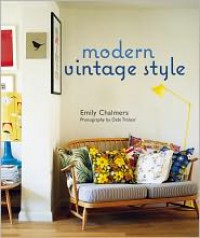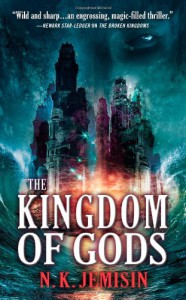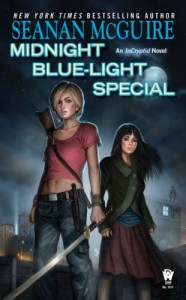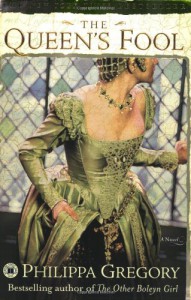
If you're new to Tortall, this book contains huge spoilers for the Immortals series and the Trickster duology, so you probably want to read those first. Tortall veterans, though, should love this book. It continues the stories of some familiar characters and creatures, and introduces others for the first time. I'm going to review each story on its own.
Student of Ostriches: Tammy takes a character who was mentioned ONCE in [b:Lioness Rampant|13837|Lioness Rampant (Song of the Lioness, #4)|Tamora Pierce|http://d.gr-assets.com/books/1348887752s/13837.jpg|1123099] and gives her a complete and awesome backstory. I won't spoil which character it is--in fact I had to look her up to figure out where I had heard her name before--but I loved this story. It's set in what is obviously an analogue for Africa, where a girl learns first to run, and then to fight, from studying the ostriches and other animals she observes on the plains near her village. She looks to her future and sees only marriage and boredom, but when she is given a chance to show her skills, she discovers there might be another option.
Elder Brother: Finally, the story of the tree from [b:Wolf-Speaker|24094|Wolf-Speaker (Immortals, #2)|Tamora Pierce|http://d.gr-assets.com/books/1347995618s/24094.jpg|1090193]! Ever since I read about Numair turning a man into a tree and how that would turn a tree into a man somewhere, I've wanted this story. It's from the tree's perspective, which is fascinating, but it also contains a Tammy staple: a girl who dresses as a boy to avoid her culture's restrictions on what girls can and can't do. Qiom, the apple tree, at first thinks he will forever be a tree trapped in a man's body, but Fadal, the girl, helps him learn to be human in more ways than one.
The Hidden Girl: This story is a continuation of "Elder Brother," but expands more on the religion from that story, which has shades of Islam. It requires that all women be veiled and covered at all times. While "Elder Brother" features a girl who rejected the veil entirely, at risk to her life, "The Hidden Girl" shows the other side: a girl who doesn't see the veil as a bad thing, and in fact uses it to her advantage. I am so glad that Tammy included this story. While her tales of girls dressing as boys are some of my favorite stories, not all girls are able or willing to do that, and many of them still want to change the sexist cultures they live in. Some women choose the veil,
and that's okay.
Nawat: NAWAT AND ALY HAVE KIDS! It was delightful to see some of the characters from the Trickster duology again. This story is from Nawat's perspective, which is really cool to see. The crows decide Nawat is being too human and not crow enough, and he has to decide which of those sides of him is more important: Will he abandon his human family, or lose the community of his flock? There's also a really sweet note here about disability and what it means to have children who aren't considered "normal." And a surprisingly large amount of poop jokes.
The Dragon's Tale: KITTEN!! Finally we get a story from Kitten's perspective, and discover how frustrated she is that she can't communicate directly with humans or animals, even though she understands everything they say. While Daine and Numair are on a diplomatic mission with Kaddar, Kitten grows supremely bored and decides to go exploring. She finds a young, starving mother who has been cast out of the village, and sets about trying to help her, with the assistance of Spots, Numair's patient horse. There's lots of delicious magic in this one, and it's great to see a continuation of Kitten's story.
Lost: This was one of my favorites. A girl with an abusive father and a talent for mathematics thinks she'll never be able to follow her dreams of studying at the University, until she meets Lost, a darking who helps her gain the confidence she needs. Darkings are so awesome.
Time of Proving: I felt like I was missing something with this one, like it was incomplete or there was some kind of context in which it would make more sense. I'd like to know more about the Wind People and the Veiled City, and the image of a bull-man who wears silk and loves art and poetry was pretty great, but the story as a whole fell flat for me.
Plain Magic: Embroidery magic is one of my favorite things Tamora has written about. A poor girl from a small town is set to be sacrificed to a dragon, but a peddler woman from out of town comes to her aid. Another story about a girl choosing a future other than the one her family and/or society has chosen for her.
Mimic: A young shepherd rescues a helpless lizard-bird-creature from becoming an eagle's snack and tries to heal it of its wounds--but what type of creature is it? A dragon, or something else? To the shepherd, it doesn't matter, and she(? I don't think the gender of the narrator is mentioned) keeps working to heal it, even when it develops a life-threatening fever and her grandfather advises her to put it out of its misery. She names the creature Mimic for its habit of imitating the calls of birds and even a dog's bark, and Mimic becomes her friend and helper as he heals. Then, during a wild storm, something awesome happens. I don't think this story is set in Tortall, but the landscape is richly painted and it's easy to imagine everything that's happening. In the end, both Mimic and Ri must make choices about the kind of future they want to have, and the kind of people they want to be.
Huntress: A story set in contemporary New York! The narrator desperately wants to be part of the cool kids' crowd at her high school, but discovers that the price of acceptance is one she's not willing to pay. She ends up fighting for her life, and calls on the Goddess to help her. Haunting and evocative. Does my favorite "Buffy the Vampire Slayer" trick of taking a high school trope to its metaphorical extreme.
Testing: LOOK TAMMY WROTE A STORY WITHOUT ANY FANTASY IN IT. It's partly based on something that happened to Tamora herself, but really it's about the need for stability and the power of Not Leaving, which as [a:Markus Zusak|11466|Markus Zusak|http://d.gr-assets.com/authors/1311632768p2/11466.jpg] says is "an act of trust and love, often deciphered by children."
 Reviewing on my second read-through of this book. I really like [b:Room Rescues: Decorating Solutions For Awkward Spaces|1640523|Room Rescues Decorating Solutions For Awkward Spaces|Jane Burdon|http://d.gr-assets.com/books/1186218376s/1640523.jpg|1634851], so I checked this one out as well. Unfortunately, it wasn't quite as useful to me as the other, because it relies too much on home renovations for its "comfort." And maybe the truth is that homes you can't change are never going to be truly comfortable for you, or something, but I wish there was more advice on creating comfort without changing bathroom fixtures and creating a kitchen from scratch. Which I suppose is what Room Rescues is for--those rooms you can't do much about.
Reviewing on my second read-through of this book. I really like [b:Room Rescues: Decorating Solutions For Awkward Spaces|1640523|Room Rescues Decorating Solutions For Awkward Spaces|Jane Burdon|http://d.gr-assets.com/books/1186218376s/1640523.jpg|1634851], so I checked this one out as well. Unfortunately, it wasn't quite as useful to me as the other, because it relies too much on home renovations for its "comfort." And maybe the truth is that homes you can't change are never going to be truly comfortable for you, or something, but I wish there was more advice on creating comfort without changing bathroom fixtures and creating a kitchen from scratch. Which I suppose is what Room Rescues is for--those rooms you can't do much about.






















